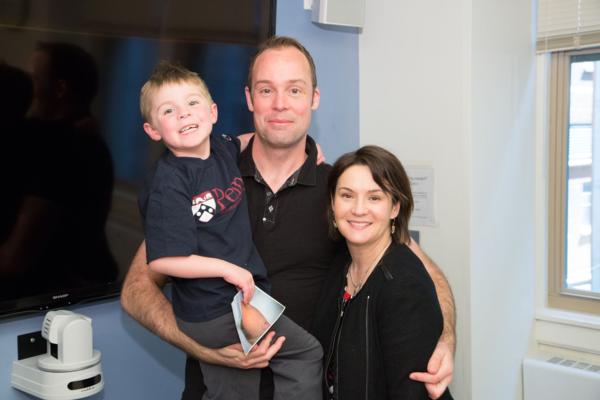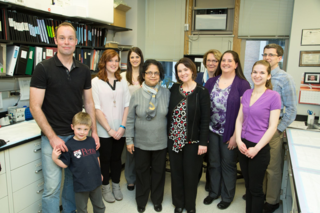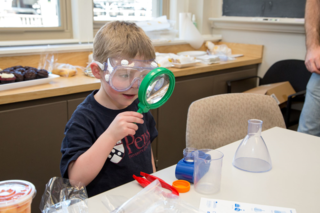
In 2009, Sarah Gray found out during a routine ultrasound that one of the twins she was carrying had anencephaly, a fatal genetic condition where the brain and skull don't fully develop. After his death, she and her husband donated Thomas’s organs and tissues and since then, have been tracking how they've been used.
Today, she’ll give a 2015 TEDMED talk in Palm Springs, Calif., to share her personal story about donating his organs to biomedical research—including the emotional and poignant visit to a genetics lab at the Perelman School of Medicine, where her son’s retinas went to the lab of Arupa Ganguly, PhD, a professor of Genetics, through the National Disease Research Interchange. Ganguly directs a genetic diagnostic lab and studies retinoblastoma, a childhood-onset cancer caused by mutations in tumor suppressor gene.
Five years after the donation, the Grays wrote a letter to Ganguly to ask how Thomas’s retinas would be used in research. “I received a letter back two days later from Dr. Ganguly, telling me how valuable Thomas's donation was to her research,” recalls Sarah. In Ganguly’s six years of researching retinoblastoma, she has only received one suitable healthy tissue sample for comparison to retinas from infants with retinoblastoma, and it was Thomas's.
Last spring, Ganguly took the Grays and Callum, the surviving twin, on a tour of the lab. The day just happened to fall on March 23, his 5th birthday, which was celebrated complete with birthday cake, a blow-up dinosaur, and of course a gift of a child’s lab kit.
That visit and the Gray family’s journey was beautifully captured by many media outlets, including WHYY radio. In a Today.com article, Ganguly commented, “I felt bad as a mother that I’m talking to another mother who has lost her son. I connected with her. I thought this is someone who wants closure.” Said Gray of the experience in the Philadelphia Inquirer: “Instead of thinking of our son as a victim, I started thinking of him as a contributor to research, to science.”
I have been keeping in touch with the Grays and wanted to hear from Sarah in her own words about the longer term significance of her family’s visit to Penn, as well as get an update on what they have been up to this fall.

What were you most surprised about in your experiences visiting the places where Thomas’ donated tissues were used?
I was surprised by two things. One was how important each research project was. Three projects were working on ways to cure or prevent deadly diseases and one was to help people who are blind to see again. I was also surprised by how grateful the researchers were and how rare a sample like Thomas's was.
You mentioned during your visit to the Ganguly lab that every time you visit the online version of a 2012 study on cord blood stem cells in the journal Molecular Vision and you see that a new study has cited this paper, you smile. You likened it to visiting a grave site for Thomas. What did you mean by that?
When some people want to feel the presence or a connection with their loved one, they visit a grave. We can do that as well. But every now and then, I also like to click on the link to the cornea study that might have resulted from Thomas's cornea donation and see all the other studies he may have indirectly helped. It reminds me that Thomas's short life had tremendous positive impact, even today. So far it's been cited by 15 studies and it continues to grow. Every time I see a new citation, I get a smile on my face.
You shared your story with Dr. Gangly in an email over a year ago. What did you hope to gain by doing that and what have you and your family learned from your visit to the Ganguly lab and getting to know the researchers there?
I assumed that whoever received Thomas's retinas would be highly educated and passionate about their work. I imagined that no one in their family really understands their job because it is so complicated. So I was hoping that they would understand that my family played a small part in what they do, and even though I am not a researcher, I care about what they do and I want to know more. I hoped that the researcher would respond to me and that they would be open to communicating with my family. I was very lucky because Dr. Ganguly has been extremely open and helpful. It was a privilege to visit the lab and meet Dr. Ganguly and the staff and to learn about what they do to help save lives. My family learned that donating to research is an incredible help to these researchers and that was an eye-opener. When we donated, it was very mysterious what was going to happen next, and the letter and the visit solved the mystery.
 After your visit to Penn, how have your family and Dr. Ganguly worked together in the last nine months?
After your visit to Penn, how have your family and Dr. Ganguly worked together in the last nine months?
Dr. Ganguly and my family have been involved in some media opportunities and some professional education. We were featured in an episode of WNYC's Radiolab in July 2015. Dr. Ganguly and I also participated on a panel discussion for organ, eye, and tissue donation professionals nationwide with the Organ Donation & Transplantation Alliance in October 2015. Dr. Ganguly has also been interviewed for my upcoming book. I have shared the story of meeting Dr. Ganguly at webinars, universities, and conferences all over the world.
I also understand that as a result of the news coverage on your visit, other parents have shared with you that they have donated their infants’ tissue for research. I know we have both heard from Dr. Ganguly how precious these donations are for research. What does all of this mean to your family and what do you have planned for the future?
Solving the mystery of what happened to Thomas's donations took us about five years, lots of emails and phone calls, much research, hundreds of miles of travel, and a lot of luck. Not every donor's family will be able to do what we did, or even want to, and not every researcher will be open to connecting. I hope that by sharing the details of our story that other families who donated for research can get an idea of what may have happened to their donation.
Also, there is a shortage of some research tissues. I hope that by sharing the details of our journey more people understand how valuable these donations are, which could lead to more people donating and possibly help medical advancements happen faster. This journey has made me realize how many ways strangers help each other in this field, and I would like all of us to be able to meet each other more. For example, during childbirth I needed a transfusion of blood. I received donated blood products from about eight or nine people, total. One day, I would like to meet them, and thank them personally for whatever pain and inconvenience they endured to donate the blood that literally saved my life. I am working on that with the blood bank now. I am also publishing a book in the fall of 2016 called A LIFE EVERLASTING: The Extraordinary Gift to Science of Thomas Ethan Gray.
The TEDMED talk by Sarah, who serves as director of Marketing and Public Affairs for the American Association of Tissue Banks, will be available to view at tedmedlive.org from November 18 to December 18, 2015.
You can follow Sarah on Twitter at @SGrayDC.
Photo credit: Daniel Burke Photography